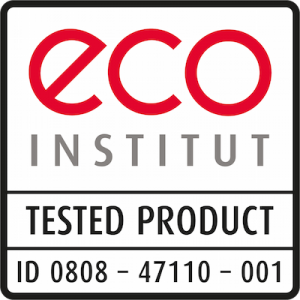Acetic acid is a volatile organic compound (VOC) that can evaporate from wood and wood-based materials. As part of eco-INSTITUT-Label certification, acetic acid is included in the emissions measurement and strictly evaluated. As acetic acid emissions have occasionally exceeded the requirement value slightly in the past, eco-INSTITUT has now re-evaluated the substance and adapted its criteria.
Acetic acid is a substance that occurs naturally in the environment, but is also often found in our own home. In higher concentrations, it has a pungent odour. Wood and wood-based materials – along with other construction products such as flooring adhesives, synthetic resin plasters or silicone sealants – are among the indoor products that can emit acetic acid. However, the acid is not added to wood and wood-based materials, but is produced when hemicelluloses – wood’s own ingredients – react with water. Wood processing under the influence of high temperatures (e.g. when drying or steaming wood) leads to an increased release of acetic acid. As hardwoods such as oak or beech have a higher proportion of hemicelluloses than softwoods, higher acetic acid emissions can generally be measured here
Restrictions for acetic acid in indoor air
Acetic acid can cause headaches and in high concentrations can irritate eyes, skin and mucous membranes. For this reason, the Committee for Indoor Guide Values (AIR) has included acetic acid (also known as ethanoic acid) in its list of indoor guide values for 2023. A concentration of 1,300 µg/m³ applies for the precautionary guideline value (RW I – RW I describes the concentration of a pollutant in indoor air which, according to current research, is not expected to have any adverse health effects even after a lifetime exposure). For the hazard guideline value (RW II), above which immediate action must be taken, the concentration is 3,700 µg/m³. For acetic acid, there is also a so-called LCI value (“lowest concentration of interest”) – a toxicologically derived guide value for individual VOC substances in indoor air – of 1,200 µg/m³. Below the LCI value, it is assumed to be harmless to health.
eco-INSTITUT-Label criteria: previous evaluation of acetic acid
 As part of eco-INSTITUT-Label certification, the products are extensively tested for harmful substances. This also includes emission tests, during which the products are placed in test chambers – small rooms made of glass or stainless steel that simulate a real indoor environment – in a defined room climate for up to 28 days. The product emissions are usually measured after 3 and 28 days. The standardised analyses also record acetic acid, which was previously assessed as part of the TVOC – the total limit value for all VOCs. In the past, this strict requirement value of 300 µg/m³ 28 days after test chamber loading was occasionally exceeded by wood products tested by eco-INSTITUT as part of its certifications due to slightly increased acetic acid concentrations. Acetic acid emissions are sometimes difficult for product manufacturers to control due to the origin and structure of the source materials.
As part of eco-INSTITUT-Label certification, the products are extensively tested for harmful substances. This also includes emission tests, during which the products are placed in test chambers – small rooms made of glass or stainless steel that simulate a real indoor environment – in a defined room climate for up to 28 days. The product emissions are usually measured after 3 and 28 days. The standardised analyses also record acetic acid, which was previously assessed as part of the TVOC – the total limit value for all VOCs. In the past, this strict requirement value of 300 µg/m³ 28 days after test chamber loading was occasionally exceeded by wood products tested by eco-INSTITUT as part of its certifications due to slightly increased acetic acid concentrations. Acetic acid emissions are sometimes difficult for product manufacturers to control due to the origin and structure of the source materials.
eco-INSTITUT-Label criteria: new requirement values
As eco-INSTITUT would like to continue to certify the renewable construction material “wood” despite natural fluctuations in acetic acid emissions, it has defined the following new requirements after weighing up health and ecological aspects: If the TVOC requirement value after 28 days of 300 µg/m³ is exceeded due to a measured acetic acid concentration, a requirement value of 350 µg/m³ for acetic acid after 28 days applies. In addition, the acetic acid concentration is then not taken into account when assessing the TVOC after 28 days, i.e. it is recorded and assessed separately from the TVOC requirement value. However, this exemption only applies if it is plausible that the acetic acid is released as a secondary emission from the wood components – i.e. the acetic acid must not be added to the product as an ingredient.
The requirement value of 350 µg/m³ for acetic acid is well below the AIR precautionary guideline value and the LCI value. eco-INSTITUT has also chosen such a large “safety buffer” because the usual VOC test chamber measurement according to ISO 16000-6 (so-called TENAX method) has higher measurement uncertainties for acetic acid due to specific analytical conditions and, in bad cases, lower results of approx. 50 % are possible, i.e. the real concentration of acetic acid is twice as high. A measurement of acetic acid in accordance with VDI 4301 Sheet 7 would be more accurate, but eco-INSTITUT has decided against this additional analysis as part of the eco-INSTITUT Label certification. As a result, certifications would be more expensive while the benefits would be limited, as the possibility of a lower result was already taken into account when determining the requirement value.
With the new assessment concept for acetic acid, eco-INSTITUT is also fundamentally following the line of reasoning of the natureplus® quality label, which changed its requirements for acetic acid in 2022.
Text: Wissen in Worten – Karin Roth
Image: e_stamm | Pixabay, eco-INSTITUT Germny GmbH
